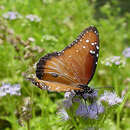en
names in breadcrumbs


All of the Danaidae are "protected" insects, having acrid secretions which make them distasteful to birds and predaceous insects. These secretions are probably due to the character of the plants on which the caterpillars feed, which are rank or even poisonous to higher animals. Other species have taken advantage of the unpalatability of the Queen and have evolved a color pattern which mimics them. One of these mimics is the Viceroy (Limenitis archippus), who uses the distasteful looks of the Queen to ward off predators who have eaten the Queens. Research has found, however, that the Viceroy is distasteful as well, but uses the same patterns so that it is easier for birds to identify it. (Douglas, 1986; Holland, 1907; Pyle, 1999)
The Nature Conservancy Global Rank: G5- Demonstrably secure globally, though they may be quite rare in parts of their range, especially at the periphery. (Struttman 2000)
US Federal List: no special status
CITES: no special status
State of Michigan List: no special status
This species is not known to adversely affect humans.
This species has no known benefits for humans besides being aesthetically pleasing.
The Queen larvae feed mostly on varieties of mildweed (Asclepias), and the members of this family are therefore called the "milkweed butterflies". They feed on Asclepias, Nerium, Funastum, Vincetoxicum, Philibertia, and Stapelia, which are all milkweeds. They are also known to feed off of the nightshade families (Solanaceae) and like the nectar plants Blue Mist, fogfruit, and shepherd's needle.
In times when nectar-bearing flowers are scarce, and competition is fierce, Queen butterflies have been seen probing the bases of grass inflorescences in Texas, but what they gain from this is yet to be discovered. (Douglas, 1986; Ehrlich and Ehrlich, 1961; Holland, 1907)
The Queen can be found ranging from Brazil to Florida and the Gulf Coast. It is also prevalent in the states of California, Texas, Arizona, and southern New Mexico. (Douglas, 1986; Ehrlich and Ehrlich, 1961; Holland, 1907)
Biogeographic Regions: nearctic (Native ); neotropical (Native )
Open, sunny areas, including fields, deserts, roadsides, pastures, dunes, washes, and waterways. Queens are known to migrate like the Monarch, but to a lesser extent. The stay mainly in warm climates year round. (Struttman 2000)
Terrestrial Biomes: desert or dune ; savanna or grassland
The Queen resembles its close relative the Monarch butterfly (Danaus plexippus) in various ways, but is smaller and the ground color of the wings is a darker brown. The forewings are long, greatly produced at the apex, and have a triangular outline. The hindwings are well rounded and smaller than the forewing. Black veins with white borders appear on the entire length of the hindwing while the forewing is not bordered with black on its inner margin like the Monarch. The light spots on the apex of the forewings are whiter and patterned differently than those of the Monarch as well. While male Monarchs are often the larger sex, in Queens, the female is larger. A Queen's wingspan averages 3 inches. Generally, this genus of butterflies (Danaus) has eggs which are ovate conical, broadly flattened at the base and slightly truncated at the top, with many longitudinal ribs and transverse cross-ridges. In the caterpillar stage, they have a small head and large, cylindrical, hairless body with dark stripes. The chrysalis is short, thick, rounded, tapers very quickly over the posterior of the abdomen, and is suspended by a long cremaster from a button of silk. It is frequently ornamented with golden spots. Member of this family have antennae that are unscaled. (Ehrlich and Ehrlich, 1961; Holland, 1907; Pyle, 1999)
Other Physical Features: ectothermic ; bilateral symmetry
To find females, males patrol all day. Females lay eggs singly on leaves, stems, and flower buds, which the larvae will eat. Adults roost communally. Males have pheromones, specific scents, which aid in mating and attract females. (Struttman 2000)